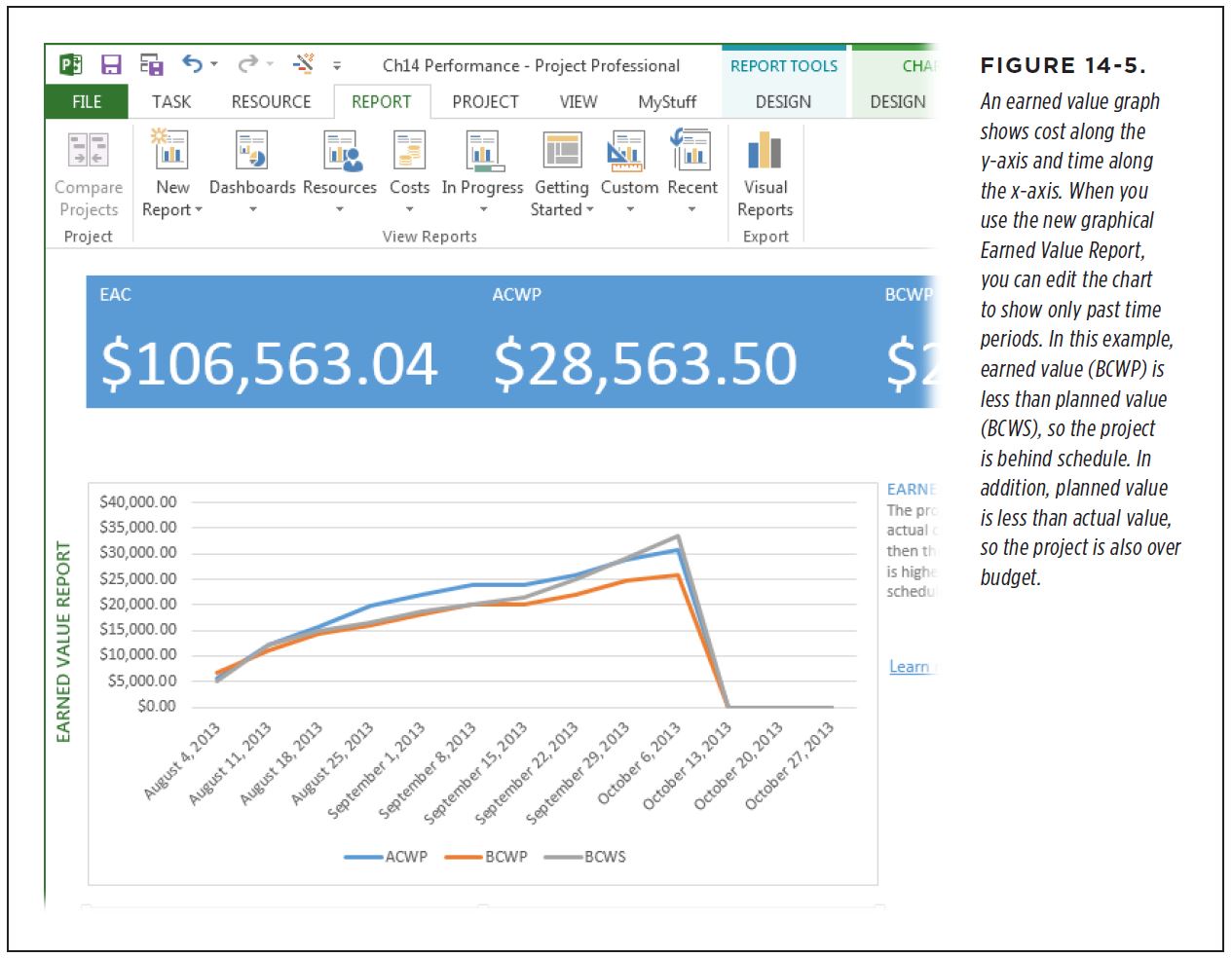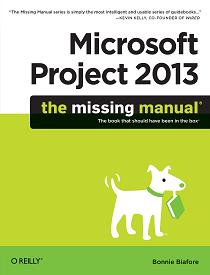 Earned Value Analysis
Earned Value Analysis
Earned value analysis is like the idea behind that old Smith Barney slogan, “We make money the old fashioned way—we earn it.” Earned value analysis measures progress according to how much of your project’s value (its cost) you’ve earned so far by completing work.
Project customers, sponsors, and stakeholders want to know how far along a project is. Earned value alone tells you only how much of the project’s cost you’ve earned—it doesn’t say anything about the schedule. Other earned value measures provide a picture of schedule status. If a project has spent half its budget, consumed half its forecast duration, and completed half of its work, you’re all set. However, if the budget and duration are half spent, but the work is only 25 percent complete, something is wrong. You have only 50 percent of the budget and duration left to complete 75 percent of the work.
Gauging Performance with Earned Value Measures
Earned value analysis uses several calculations to measure schedule and cost status. However, all earned value measures are based on three basic measurements:
- Planned cost for scheduled work. In project-management circles, you’ll hear planned value described as the budgeted cost of work scheduled (or BCWS, which is also the name of the corresponding Project field). In English, planned value is the cost you expected to incur for the work scheduled through the status date—that is, the baseline cost for the work that should have been completed as of the status date.For example, suppose you’re managing a tiger-taming project that’s scheduled to tame 24 tigers over 24 months for a total cost of $240,000—$10,000 per tiger. According to that plan, 10 tigers should be tamed at the end of 10 months at a planned value of $100,000.
- Planned cost for completed work. This measure is called earned value because it represents the baseline cost you’ve earned by completing work as of the status date. It’s also known as budgeted cost of work performed or BCWP (the name of the corresponding Project field). For example, if you’ve tamed six tigers as of the status date, then the earned value is $60,000.
- Actual cost of completed work. Actual cost is easy: It’s how much you actually spent as of the status date. For example, if you’ve spent $50,000 through the first 10 months of tiger taming, that’s your actual cost of completed work. This measure is sometimes called actual cost of work performed or ACWP (again, the name of the Project field).
Tactical Note: Earned value analysis requires a baseline in your Project file, so you have a plan to compare to. If you haven’t set a baseline yet, all the earned value fields are zero. You also have to set a status date and enter actual values as of that date to show what you’ve accomplished and how much it cost.
Analyzing an Earned Value Graph
Because planned value, earned value, and actual cost are all monetary values, you can compare them to evaluate schedule and cost performance. In earned value graphs, the relative positions of the three lines for these measures show whether the project is on schedule and within budget.
Gleaning schedule and cost performance from an earned value graph is easy once you know how to compare planned value, earned value, and actual costs. The Earned Value Report, a new graphical report shown in Figure 14-5, graphs all three measures over time. Here’s how you evaluate schedule and cost performance with these three measures:
- Schedule performance. The comparison between planned value and earned value is what provides you with a schedule status. Planned value is the baseline cost for the work you expected to complete, while earned value is the baseline cost of the work that’s actually complete. If earned value is less than planned value (like $60,000 versus $100,000 in the tiger-taming project), less work is complete than you expected—thus, the project is behind schedule. If earned value is greater than planned value, then more work is complete than you expected, and the project is ahead of schedule.

- Cost performance. This is the difference between earned value and actual cost. If the earned value is greater than the actual cost, then the work performed cost less than you planned—the project is under budget. For example, the earned value for the tiger taming project is $60,000, while the actual is only $50,000, so it’s $10,000 under budget. If earned value is less than the actual cost, then the project is over budget.
View the entire excerpt
Thinking Like a Project Pro: Bonnie Biafore
Being a Microsoft Project expert, share with the MPUG community a favorite tip to using Microsoft Project like a Pro?
I’ll give you two tips, because choosing only one is too tough. These tips might elicit some “Well, duh!”s from the audience, but I end up talking about them with a lot of my clients.
- Get task dependencies set up correctly.
Dependencies are a big part of how Project calculates a project schedule. Get to know each type of task dependency (finish-to-start, finish-to-finish, start-to-start, and start-to-finish) so you can choose the right type of dependency. (I have some fun examples for each type in my book.) Use lag time (positive or negative) to fine-tune task dependencies.Stay away from links to summary tasks. Instead, include milestones to flag the start and finish of portions of a project, and link work tasks and milestones. That way, you can see all the schedule logic even if you hide the summary tasks. A view of only summary tasks shows a high-level schedule perspective without task link spaghetti. - Make the most of milestones.
The familiar diamond shape of milestone tasks is appropriate, because milestones really are gems. They come in handy in all sorts of ways.You can add milestones to mark the beginning of portions of a project. That way, if that part of the project is delayed, you can reschedule the milestone, and Project takes care of rescheduling all the work tasks that follow. Milestones are great at the end of summary tasks for showing the progress that’s been made.You can also include milestones for decisions and approvals. For example, if you can’t start the next project phase until management makes a decision or approves funding, add a milestone for that decision or approval. Then, when you record the actual date for the decision or approval, Project reschedules the work tasks accordingly.Milestones also come in handy to represent deliveries. You don’t necessarily care what’s going on at a supplier’s warehouse. What matters to your project is when the materials you need show up.
What can readers expect to be able to do better after reading your book, “Microsoft Project 2013: The Missing Manual”? What is your writing style?
O’Reilly Missing Manuals focus on “why” before getting into “how”. I start each section of the book with the project management case for a Project feature (why the heck would I need this in managing a project?), and then how to use it effectively. So you won’t read something like “To add a freeblesnap, click this, then click that, then press Enter,” and then wonder what’s a freeblesnap and why you’d want to add one. If you find a section with a missing why, shoot me an email. I’ll fix it.
This approach helps readers learn a little bit more about project management and how to use Project at the same time.
However —- with each revision of my Project Missing Manual, there is always at least one “feature” whose purpose escapes me. When that happens, I ask my tech reviewers, friends in the Project community, and Project forums. Every once in a while, a feature remains a mystery.
I also try to make examples funny. Project management and Project books can get downright dry and dull. I yacked up hairballs reading a couple of PM books.
Do you have a favorite feature of Project 2013 that you can share with our audience? If you could turn one feature “off,” what would it be?
I really like the new graphical reports. They make it easy to see what’s going on in a project and they’re easier to work with than visual reports. For instance, you can produce an earned value graph in no time. However, I miss the old text reports. You can recreate a lot of them with graphical reports, but they aren’t built-in.
For part b of the question, I wish Project default settings were set up for people who use Project to calculate the schedule. Default Project option settings these days are set up for the beginner-level user. One example is that the option for task mode is set to Manually Scheduled out of the box. Sure, Microsoft is trying to make Project less intimidating to beginners, at the expense of project managers who manage schedules day in day out.
Maybe Project could have an option with two settings, like Casual and Scheduler. With the Casual setting, Project would choose Project options for someone who mainly does manual scheduling. Selecting Scheduler would set up the program to calculate the schedule and put other more advanced settings in place.
Managing your consulting company, writing, and contributing to the project community must be incredibly time consuming. How do find time?
You’re right. Managing myself is incredibly time-consuming. I’m a bad employee and an even worse boss.
I have gotten everything done by working a lot–weekends and sometimes pretty late into the night. As of this Spring, I’m starting to rein in my workweek.
I keep things organized, almost to the point of being OCD. That helps me get a lot done, because I don’t have to look for things and I know what’s due when. I build templates for documents, projects, and tracking what I work on.
I really absorb the software I use, so I can be more productive with it. That’s just the way I’m wired. That’s probably why I ended up writing books. I learned about small business accounting and QuickBooks in managing my little one-person corporation but that led to the QuickBooks Missing Manual. I learned about project management and Project in my job and that led to a boatload of books and courses on both those topics.
One bit of my mad science is working on my to-do list to maximize my energy level. Working on items in order of importance is good most of the time, but if I feel my motivation waning, I’ll knock out something easy and not so important. Scratching something off my list gives me an energy boost that can help me slam through another much tougher task.
Do you have a motto, credo or general slogan that you live by?
In those exercises that ask how you want people to remember you, my answer is “She was tough but fair.” I’ve always been tough, but I’m getting better at the fair part as time passes.
I believe in sharing with others, whether it’s knowledge, power, or the last scoop of ice cream. Karma is a positive reality to me. By sharing with others, I end up receiving a lot in return. One caveat: sometimes, I have to say no, because good karma still doesn’t increase the hours in a day.








